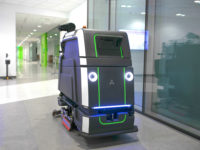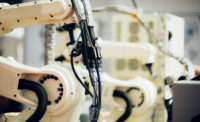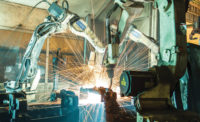 A recent article In the New York Times highlighted the growing use of robots in industrial operations, moving about with greater freedom and dexterity than ever thanks to technology. But OSHA and NIOSH have had their eyes on robot risks since the 1980s.
A recent article In the New York Times highlighted the growing use of robots in industrial operations, moving about with greater freedom and dexterity than ever thanks to technology. But OSHA and NIOSH have had their eyes on robot risks since the 1980s.
From OSHA’s “robotics” web page: “Industrial robots are programmable multifunctional mechanical devices designed to move material, parts, tools, or specialized devices through variable programmed motions to perform a variety of tasks. Robots are generally used to perform unsafe, hazardous, highly repetitive, and unpleasant tasks. They have many different functions such as material handling, assembly, welding, machine tool load and unload functions, painting, spraying, and so forth.
Studies indicate that many robot accidents occur during non-routine operating conditions, such as programming, maintenance, testing, setup, or adjustment. During many of these operations the worker may temporarily be within the robot's working envelope where unintended operations could result in injuries.
There are currently no specific standards for the robotics industry. “
More from the OSHA web page: “In order to make an impact in reducing the number of injuries and fatalities due to robotics in the workplace, more than just hazard recognition needs to occur. It is important that once the hazards are identified that measures of control for worker safety are put into place and followed. The following references aid in evaluating hazards and possible solutions to controlling robotic hazards in the workplace.”
Hazard Evaluation
National Occupational Injury Research Symposium (NOIRS). National Institute for Occupational Safety and Health (NIOSH).
Control and Prevention
Training Requirements in OSHA Standards and Training Guidelines. OSHA Publication 2254, (Revised 1998). Also available as a 720 KB PDF, 110 pages. Personnel who program, operate, maintain, or repair robots or robot systems should receive adequate safety training and be able to demonstrate competency in performing their jobs safely.
Concepts and Techniques of Machine Safeguarding. OSHA Publication 3067, (Revised 1992).
Chapter 6 - Robotics in the Workplace. Points out robotic applications, hazards, and possible safeguarding measures.
Health & Safety Manual. Lawrence Berkeley National Laboratory, Environment, Health and Safety (EH&S) Division.
OSHA case studies
• At an employer's automotive component manufacturing facility, manufacturing operations make extensive use of robots located within fenced cages. At one location, suspension parts are transferred by rotating tables from station to station while greasing and other operations are performed on the parts by robots. If necessary, employees can gain access to the robots by entering the cages through electrically interlocked gates. When the gates are opened, the multiple energy sources that power the robots, rotating tables, and related machinery are turned off but are not deenergized or locked out. An employee who is inside a cage when a robot is activated could be struck by the robot arm or other machine parts and seriously injured.
An injury occurred when an employee, consistent with the employer's practices, entered the robot cage without deenergizing or locking out any equipment. The employee was attempting to unjam a robot arm. In freeing the arm, the employee tripped an electric eye, causing the robot arm to cycle. The employee's arm was struck by the robot and injected with grease. The employer contends that lockout procedures were not necessary because once the gate is opened, movement of the robot arm is impossible, and a maintenance worker inside the cage would have ample warning – by the closing of the interlocked gate – before the machinery started up, to avoid injury. According to the employer, once the interlocked gate is opened, it must first be closed and a number of buttons must be pushed before any machine movement can occur. The startup procedure would take some time and the person inside the robot area would be aware of the closing of the gate and the presence of another worker at the nearby control panel.
• On January 19, 2001, a 29-year old male died from injuries sustained when he was struck on the head by a cycling single-side gantry robot. The victim had recently performed a mold change on a 1500-ton horizontal injection-molding machine (HIMM). He was apparently looking for tools that he may have left within the machine during the set-up operation. The victim climbed on top of the purge guard and leaned over the top of the stationary platen of the HIMM in an attempt to see if the tools were left within the mold area, and placed his head beneath the robot’s gantry frame. His position placed him between the robot’s home position and the robot’s support frame on the stationary platen. While trying to look inside the mold area, the robot cycled, and the victim’s head was struck from the side and crushed between the robot and the robot’s support frame. Another employee noticed the victim on top of the HIMM and went to investigate. Upon seeing the victim’s condition, fellow employees were called to move the victim to the floor. Emergency responders were called, and awaiting emergency responder arrival, employees began chest compressions and other first aid procedures. The victim was pronounced dead on arrival at the local hospital.
Recommendations:
The robot and the point of operation should be safeguarded to prevent entry during automatic operation.
Users should conduct a risk assessment of the robot/robot system to identify equipment, installation, standards, and process hazards so adequate employee safeguards are provided.
Users should ensure that personnel who interact with the robot or robot system, such as programmers, teachers, operators and maintenance personnel are trained on the safety issues associated with the task, robot and robot system.
• A 23-year-old carousel operator at a meat packing plant was killed when his foot tripped a light sensor causing a computer controlled robotic platform to come down from above, crushing his skull. He had been watching a maintenance technician work on a conveyor and apparently stepped on the conveyor to get a better view of what the mechanic was doing. The conveyor the mechanic was working on had been shut off but the entire system had not been locked out. Power still remained to the light sensors and the robotic platform. When the platform came down it pinned the victim between the platform and the conveyor. When they lifted the platform off the victim, the victim fell approximately 15 feet to the concrete floor below. Death was most likely caused by the blow to the head from the robotic platform, not the fall. The victim was pronounced dead at the scene.
The Nebraska Department of Labor Investigator concluded that to prevent future similar occurrences employers should:
- ensure all equipment is properly locked out/tagged out prior to performing maintenance on it.
- consider implementing a spot inspection program to ensure all employees are complying with safety requirements.
- develop procedures to ensure individuals not involved in maintenance activities are not in the immediate area of the maintenance being performed.
- consider installing a protective grate around access areas to the robotic platform.


